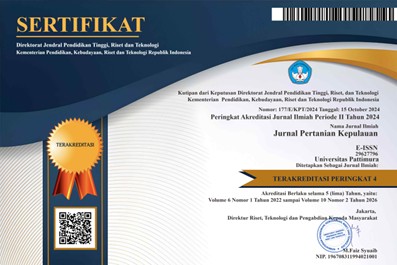Pengujian Kadar Air Biji Kakao (Theobroma cacao L .) dengan Suhu Tinggi dan Rendah Terhadap Kualitas Biji Kakao
Abstract
This study aims to compare the methods of testing the moisture reduction of cocoa beans with the high-temperature and low-temperature oven methods. The method used in this study was a comparative test between three cocoa clones and two moisture content test methods, namely using a low-temperature oven and a high-temperature oven. This research is experimental using a completely randomized design (CRD). The results of the cocoa moisture content test showed that each treatment of K2O2 and K1O2 was not significantly different from the results of the moisture content of cocoa beans. In contrast, the comparison of each treatment of K2O2, K1O2 and K3O2 was significantly different from the results of the moisture content of cocoa. Furthermore, for the K3O2 treatment compared to each of the K1O1, K2O1, and K3O1 treatments, the results of cocoa content were significantly different. For each treatment, K1O1, K2O1, and K3O1 did not differ significantly in the results of the moisture content of cocoa. High temperatures and low temperatures in Table 2 show that the K1O1 yield is 8.03%, significantly different from the K1O2 cocoa bean moisture content, which is 9.59%. and K3O1 7.57% with K3O2 which is 8.85 Testing the moisture content of cocoa seeds using the high-temperature oven method for 2 hours was significantly different from the low-temperature oven method for 17 hours. The proper method for testing the moisture content of cocoa beans is high temperature for 2 hours.
Downloads
References
Amin S. (2005) Teknologi Pasca Panen kakao untuk Masyarakat Perkakaoan Indonesia. Badan Pengkajian Dan Penerapan Teknologi BPPT Press, Jakarta.
Bloom, J dan Reenen, van J. 2019. Analisis Mutu Biji Kakao (Theobroma Cacao L) Dari Desa Tombolo Dan Desa Kaloling Di Kabupaten Bantaeng Dengan Variasi Suhu, NBER Working Papers.
Botutihe F, Kusumaningrum M, Jambang N. 2020. Strategi Pemenuhan Syarat Mutu Standar Nasional Indonesia (Sni) Biji Kakao Fermentasi, Jurnal Teknologi Pertanian, Vol.21, No.3.
BPS Provinsi Maluku, 2021. Maluku dalam Angka Tahun 2020. BPS Provinsi Maluku.
BSN. 2008. SNI Biji Kakao 01-2323-2008. Jakarta
Chahyaningrum Nurdeana, Anisa Safitri, Mahargono Kobarsih, Mohammad Fajri, Tri Marwati (2019). Kajian Pengeringan Kakao Hasil Panen Akhir Musim di Gunung Kidul Yogyakarta. Jurnal Research Fair Unisri 2019. Vol 3, Numbar 1, januari 2019.
Dand, R. 2011. The International Cocoa Trade. Third edition. Woodhead Publishing.
Diby, L Kahia, J, and Kouame C. 2017. Tea, Coffee, and Cocoa World Agroforestry Centre (ICRAF), Abidjan, Ivory Coast E Aynekulu, World Agroforestry Centre (ICRAF), Nairobi, Kenya
Dina Sari Farah, Farel H. Napitupulu, Himsar Ambarita. Kajian Berbagai Metode Peneringan untuk Peningkatan Mutu Biji Kakao Indonesia. Jurnal Riset Industri Vol. 7, No. 1, 2013, Hal. 35-52.
Direktorat Jenderal Perkebunan. 2016. Statistik Perkebunan Kakao 2014-2016. Jakarta. Direktorat Jenderal Perkebunan
Ginting N. M, Rahmanta R, dan Lindawati L. 2021. Analisis Daya Saing Kakao Olahan dan Faktor-Faktor yang Mempengaruhi Daya Saing Kakao Olahan Provinsi Sumatera Utara, Indonesia di Pasar Internasional, Agro Bali : Agricultural Journal
Ifmalinda, Edo Saputra, Dinah Cherie, (2023).Pengaruh Suhu Pengeringan terhadap Mutu Kakao (Theobroma Cacao. L) Varietas Klon BL 50 Pasca Fermentasi. Jurnal. Teknotan, Vol. 17, No 2, Agustus 2023.
[ISTA] Internasional Seed Testing Association. 2010. International Rules for Seed Testing: Edition 2010. The International Seed Testing Association. Switzerland (CH): ISTA.
Kusuma, I. Gusti Ngurah Sujana, I Ngenah Kencana Putra, Luh Putu Trisma Darmayanti (2019). Penaryh Suhu Pengeringan `Terhadap Aktivitas Anti Oksidan Teh Herbal Kulit Kakao (Theobroma cacao L.). Jurnal Ilmu dan Teknologi Pangan Vol.8, No.1, 85-93
Muñoz, M. S., Cortina, J. R., Vailant, F. E., Parra, S. E. 2019. An Overview Of The Physical And Biochemical Transformation Of Cocoa Seeds To Bean And Chocolate: Flavor Formation. Crit. Rev. Food Sci. Nutr. 60 (10): 1593-1613. doi: 10.1080/10408398.2019.1581726
Nengsih, Yulistiati, Defitri, Y, Levia, T. 2020. Daya kecambah dan kekuatan Tumbuh Benih Kakao (Theobroma cacao. L) pada Berbagai media Simpan. Jurnal Media Pertanian.
[PUSLITKOKA] Pusat Penelitian Kopi dan Kakao Jember, 2014. Deskripsi varietas Kopi Robusta. Jember: Pusat Penelitian Kopi dan Kakao
Rachmatullah, D, Putri, D, Herianto, F, dan Harini, N. 2021. Karakteristik Biji Kakao (Theobroma cocoa L.) Hasil Fermentasi Dengan Ukuran Wadah Berbeda, VIABEL: Jurnal Ilmiah Ilmu-Ilmu Pertanian, Vol.15, No.1.
Tridge, 2021. Industry report: Cocoa beans. https://cdn.tridge.com/market_report_ report/24/ 8e/b5/ 248eb54e641bb3bd67 b2e7 d4a976929c31509d62/Industry_Report_-_Cocoa_ beans.pdf
Wahyudi.T dan Misnawi. 2007. Fasilitasi dan Perbaikan Mutu Kakao Indonesia. Warta Pusat Penelitian Kopi dan Kakao Indonesia, Jember.
Widhiyoga, G. 2022. Challenges Faced By Cocoa-Based Industries From Indonesia In Global Value Chains. Husnayain Business Review, 2(2): 1-10
Wiratakusumah, A, Subarna, M. Arpah, Dahrulsyah, dan S.I. Budiwati, 1992. Peralatan dan Unit Proses Peralatan. Pusat Antar Universitas Pangan dan Gizi – Institut Pertanian Bogor, Bogor.
Wood, G.A.R. 1985. From Harvest to Store, in G.A.R. Wood & R.A. Loss (ed.). Cocoa. Logman. London.
Copyright (c) 2024 Jefinta Porsiana, Marthini K Lesilolo, Johan Riry

This work is licensed under a Creative Commons Attribution 4.0 International License.





.png)


